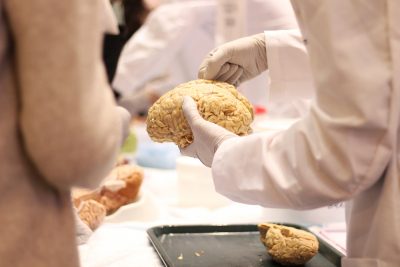
Children and adults shuffle around a circle of tables, examining various instruments and technologies on the tables. Some tables have computer screens with complex graphs and information, while others have medical instruments that look no different from ones that can be found in a doctor’s office. The main activity that drew the biggest crowd was at the table where museum visitors could hold a sheep brain, a horse brain and even a human brain.
On Friday and Saturday, the Museum of Science hosted “Health Fair: Brain Works,” focusing primarily on the brain and the different technologies that were developed to research it and treat brain diseases and disorders. Museum educators worked alongside guest scientists and engineers to host educational, hands-on activities for both children and adults alike to learn about the brain.
Justin Harris, program manager at the Museum of Science’s Hall of Human Life, organized the event and gathered scientific professionals to educate museum visitors and give them general exposure to the topic of the brain.
“It’s a chance for the public to come in and meet local researchers, engineers and doctors to learn about different health topics,” Harris said. “The specific theme this year is about the brain and technology. A lot of people are talking about how they use technology to learn about the brain, to help people who have problems with their brain, and just all sorts of different ways thinking about how those two things interact with each other.”
There were several featured presentations given throughout the weekend, one of which was given by Rhoda Au, a professor in Boston University’s Department of Anatomy and Neurobiology. Au spoke about technology’s contribution to researching and treating brain health.
Scientists and researchers who came from all over the Boston area also hosted booths with various activities that catered to both young and old. Participants included individuals from the Tufts University Maguire Lab, the McLean Mammalian Research Center, the Brigham and Women’s Hospital Shah Lab and many more. One of the participating groups was from BU, the Boston University Center for Military and Post Deployment Health.
At the booth, BU medical students performed neurological exams, similar to procedures conducted by doctors in a medical office, said Anna Hohler, the director of the BU Center for Military and Post Deployment Health. Members of the group also held a presentation on deep brain stimulation and microelectrode stimulation.
Hohler said that the group’s participation in the event goes beyond simply educating the public, and also serves as inspiration for the youth to pursue the field of neuroscience.
“A lot of what we’re trying to do is outreach to the community about neurological problems and how technology can improve outcomes, and also getting young minds inspired about the brain and interested in careers in neuroscience, whether that be engineering, medicine, or others,” Hohler said.
Hohler said she enjoyed sharing her passion for the brain with the museum visitors, adding, “Every day, we are thinking about the brain, but that’s not something that the public gets exposed to very commonly. It’s nice to see them inspired by the same things that we love.”
Olindi Wijesekera, a third-year graduate student in BU’s School of Medicine, agreed with Hohler’s point on community outreach, emphasizing the importance of curiosity that most children have.
“It’s really important to do community outreach and talk to families and kids and get them interested in science at a really young age,” Wijesekera said. “Especially in kids, I think they’re so curious. It’s good to talk to them about science at a really early age to see if they can get interested in it, so hopefully they can be the next generation of scientists and doctors.”
Spending her day off volunteering at the health fair by performing neurological exams, Wijesekera recalled her favorite “patient” that she treated during the health fair.
“This little girl, who was really shy, and didn’t really know what anything was at the table,” Wijesekera said. “I put the stethoscope on her, and she listened to her own heartbeat, and then she just brightened up. She said, ‘Oh my gosh, it sounds like a little horse gallop!’ Then she listened to her brother’s and her dad’s. It was really awesome.”
While the health fair served to educate museum visitors on the study of the brain, Harris said there is still more for neuroscientists to learn in the field. However, Harris said the health fair creates more transparency of brain research between scientists and the public, making sure everyone is updated on current brain discoveries.
“The brain is the last big frontier in a lot of ways, when it comes to understanding humans and how we work,” Harris said. “There’s just so much that we don’t know about how our brain works and what’s going on inside. With all of this new cutting-edge research, the health fair is a really great way for people to see what science has told us, what it can tell us and a chance for our visitors to learn about the scientific process and the engineering process through a topic that they care quite a bit about, because everybody has a brain.”


























































































































